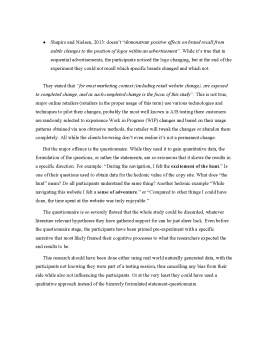Extras din referat
Introduction
The authors (Ainsworth and Ballantine) seek through this study to understand consumers’ cognitive responses to retail website changes, and to develop an empirical model with prediction capabilities.
To do this, they have focused on two specific taxonomic definitions of change:
1.Task-relevant change - any change that is relevant or affects/impairs the fulfilment of an action on behalf of the consumer.
2.Non-task-relevant change - mainly aesthetic changes or visual one.
Before enunciating their hypotheses, they went through the available literature that they consider relevant to their research questions:
1.Importance of the retail website - retail websites can be thought of as telepresence and an interactive virtual exchange environment. Thus, consumers should have specific responses towards changes to the retailer’s website.
2.Responses to change - Change, as defined by their chosen literature, is “the transformation, over time, of a well-defined, enduring structure”. With a specific distinction between observing change in progress and observation that something has changed.
3.Cognitive response to website change - the literature states that environments can act as a stimulus, eliciting behaviour based on rational needs to understand and categorise, and that environments which provide an appropriate level of exploration potential (elicit curiosity, richness, involvement, information) while also providing the ability to understand and comprehend the environment, are positively appraised. Thus they use “curiosity and control” as response variables when examining cognitive responses.
Hypotheses
The authors forwarded 13 hypotheses, which I’ve grouped according to their variable:
1.Change - Curiosity: Their literature states that incongruent stimuli evoke curiosity thus motivating exploration.
a.H1: There is a positive relationship between the perception of task- relevant change and the degree of curiosity elicited by the website.
b.H2: There is a positive relationship between the perception of non-task- relevant change and the degree of curiosity elicited by the website.
2.Change - Control: When change happens in the environment, preexisting patterns of behavior become useless for achieving desired outcomes.
a.H3: There is a negative relationship between the perception of task-relevant change and the perception of control.
b.H4: There is a negative relationship between the perception of non-task-relevant change and the perception of control.
3.Change - Perceived performance
a.H5: There is a negative relationship between task-relevant change and perceived performance, which is mediated by the perception of control.
4.Control - Utilitarian / Hedonic
a.H6: There is a positive relationship between control and utilitarian value.
b.H7: There is a positive relationship between control and hedonic value.
5.Curiosity - Hedonic
a.H8: There is a positive relationship between the degree of curiosity elicited by the website and hedonic value.
6.Performance - Hedonic / Utilitarian
a.H9: There is a positive relationship between perceived website performance and hedonic value.
b.H10: There is a positive relationship between website performance and utilitarian value.
7.Intention to return - Performance / Utilitarian / Hedonic
a.H11: Website performance has a positive effect on intention to return to the changed website.
b.H12: Utilitarian value has a positive effect on intention to return to the changed website.
c.H13: Hedonic value has a positive effect on intention to return to the changed website.
Methodology
The authors chose a website from the banking sector and created a copy of it to which were made alterations according to their task-related/non-task definition of change with a two levels of effect, high vs low, meaning some changes were more obvious compared to others. Thus resulting in four total copies.
Preview document
Conținut arhivă zip
- Consumer Behaviour - Consumers cognitive response to website changes.docx












